Timaru Star II Restorations
We know from customizing model horses that it's easier to work on a body than to start from scratch... ten times easier. The same is true of model tack. 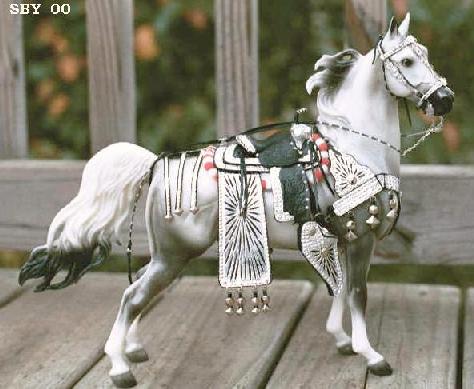 Updating, restoring, altering, customizing, rebuilding: no matter what you call it, it makes so much sense. It's cheaper and easier than buying new and it gives invaluable practice. Why make the job harder for yourself? Besides the fun of raising some piece of tack up to a higher level of detail, there is also knowledge to be gained about repair. Believe me, model tack needs repairing! just like its full size counterpart. The TSII has seen its full share of repair jobs --- it is always wonderful to spend time with old friends. This page tells the stories of several Parade sets and one Four-hitch of draft harness, all of them restored or rebuilt in some fashion.
Updating, restoring, altering, customizing, rebuilding: no matter what you call it, it makes so much sense. It's cheaper and easier than buying new and it gives invaluable practice. Why make the job harder for yourself? Besides the fun of raising some piece of tack up to a higher level of detail, there is also knowledge to be gained about repair. Believe me, model tack needs repairing! just like its full size counterpart. The TSII has seen its full share of repair jobs --- it is always wonderful to spend time with old friends. This page tells the stories of several Parade sets and one Four-hitch of draft harness, all of them restored or rebuilt in some fashion.
In 2000 I invented a method of repairing silver-tape that offered hope to the dozens of ageing Parade Sets out there. A wave of restoration activity followed. One of the first pieces to return is shown here: 'Lonely Hearts' wearing "Northern Brilliance" TSII Parade set #375, originally built in 1994. 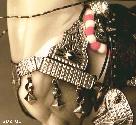 Some of the tape had begun falling off. It is seen here restored, with missing places retaped and the whole set carefully conserved by lacing down with Mylar tinsel. Click on the close-up of his shoulder, and see if you can spot the slightly-brighter silver areas where the Mylar lacing holds down the silver tape. Some are at the top of the shoulder, others at the top of the tapadero, and at the chest edge of the rectangular plate next to the chest shield. To repair a set like this, some places need invasive surgery (the corners of the triangle-shaped plate) and some places hide the lace perfectly (the small squares). Each parade set has different needs.
Some of the tape had begun falling off. It is seen here restored, with missing places retaped and the whole set carefully conserved by lacing down with Mylar tinsel. Click on the close-up of his shoulder, and see if you can spot the slightly-brighter silver areas where the Mylar lacing holds down the silver tape. Some are at the top of the shoulder, others at the top of the tapadero, and at the chest edge of the rectangular plate next to the chest shield. To repair a set like this, some places need invasive surgery (the corners of the triangle-shaped plate) and some places hide the lace perfectly (the small squares). Each parade set has different needs.
RESCUING PARADE SETS:
We have known since 1992 that the adhesive under the silver tape weakens with age. Sometimes only a few places on the set are affected. These places are almost always where the leather bends and flexes: the tops of the fenders and serapes (drapes); the tops of the bridle crown; the tops of the hip drops; and, sometimes, the edges of the skirts. Care and use also have an effect on the life of the adhesive. Sealed-away saddles last longer, while well-used ones tend to loosen up sooner.
It was in late August 2000 that I bought a new paintbrush while exploring new silvering techniques...I was in the hobby store where there was a sale. That got me thinking about recycling paintbrushes. I had a couple of beautiful old long red handles, with horrible nylon bristles. One handle became a sort of edge-slicker. I jammed a needle into the other, honed it down to a chisel, and not exactly in a flash of light started exploring ways of combining an old friend---Mylar tinsel lacing, long used for harness and Western---with an old silver enemy. Why does it take so long for new ideas to develop? One might as well ask why it takes so long to make tack. There needs to be a confluence of extra time, extra resources and extra creativity.
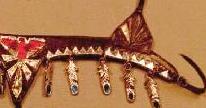
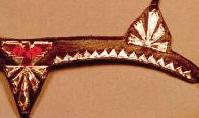 These two shots show the breastcollar of parade saddle TSII #306, BEFORE (feathers) and AFTER (still have to put the feathers back on). Note how the rays were falling off the near shoulder panel, and the triangles missing. I had to pierce the silver tape to hold down the triangles; note the dimples. For the squares and diamonds, the needle slit punch fit easily into the edge shadows.
These two shots show the breastcollar of parade saddle TSII #306, BEFORE (feathers) and AFTER (still have to put the feathers back on). Note how the rays were falling off the near shoulder panel, and the triangles missing. I had to pierce the silver tape to hold down the triangles; note the dimples. For the squares and diamonds, the needle slit punch fit easily into the edge shadows. 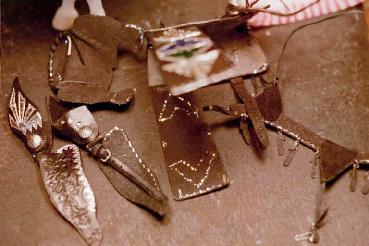 My usual method of lacing is not with a needle, but by cutting a point to the end of the Mylar tinsel, and using a sharp thin awl to open up the holes. Delicacy is called for so as not to tear the silver tape.
My usual method of lacing is not with a needle, but by cutting a point to the end of the Mylar tinsel, and using a sharp thin awl to open up the holes. Delicacy is called for so as not to tear the silver tape.
The Mylar tinsel lace is flexible, easily cut, and relatively easily tied (it can be slightly stretched). It is silver on one side, gold on the other. Best of all, it can be purchased at fly-fishing places for mere pennies. :) The picture shows lacing down finished on the fenders, serapes & breastcollar of TSII #306. Below is the entire set on 'Fancy'. It did not originally have hip drops. These hip drops were created by silver-lacing up black wide lace.
One problem of lacing down is what to do with the back side. 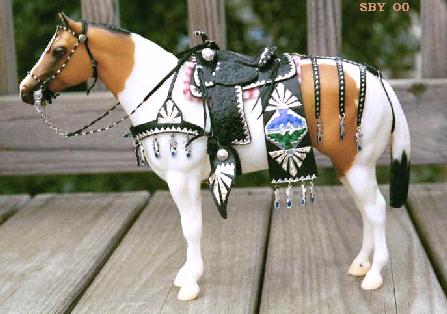 If it is left uncovered, access is easy in case further repairs are needed... a caution that is only fair and reasonable. But on a black saddle, the glittery ends, tied anyhow, are a mighty distraction. On the three sets done so far, I've lined the concerned panels with thin black suede or other very thin leather. At the time, the way I lined was to bevel the edges of suede extremely thin and glue down the lot. (Later, possession of very thin black leather solved this problem.) The lining adds beautiful heft and a feeling of strength and security, as well as a wonderful black softness to the tack. It also completely removes any chance to further repair the silver tape or Mylar in the future. :( All I can say is experiments are continuing. Perhaps I can sew down linings in the future...
If it is left uncovered, access is easy in case further repairs are needed... a caution that is only fair and reasonable. But on a black saddle, the glittery ends, tied anyhow, are a mighty distraction. On the three sets done so far, I've lined the concerned panels with thin black suede or other very thin leather. At the time, the way I lined was to bevel the edges of suede extremely thin and glue down the lot. (Later, possession of very thin black leather solved this problem.) The lining adds beautiful heft and a feeling of strength and security, as well as a wonderful black softness to the tack. It also completely removes any chance to further repair the silver tape or Mylar in the future. :( All I can say is experiments are continuing. Perhaps I can sew down linings in the future...
REBUILDING HARNESS
There is a very long story behind this harness. It begins in 1994 when a customer ordered a Draft pair. The thumbnails show this harness as it was in August 2000, pretty much the same, having only new reins and hames. 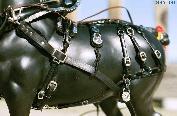 The set was made for Breyer's Belgian, and used exclusively Sojourner Studio harness brasses (made by Sue Rowe). Little did I know those brasses were to be involved in 20 months of gridlock.
The set was made for Breyer's Belgian, and used exclusively Sojourner Studio harness brasses (made by Sue Rowe). Little did I know those brasses were to be involved in 20 months of gridlock.
After the Stone Trotting Drafter came out, the customer wanted the harness refitted for these larger horses. She also ordered a second, Lead pair, to make a Four in Hand hitch 'to pull a circus wagon'. I said yes in February of 1999. Alas, that was the start of a very bad year. Orders that should have taken 3 months took 6; by fall, everything was pushed back a year. The Four Hitch order was the last in line, and thus was pushed back the most... and this was not the worst. More Rowe brasses were proving difficult to obtain. 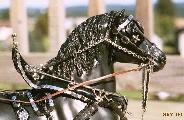 Sue said she would send me the last ones left... and in one of those horrible postal flukes, they never arrived. :(
Sue said she would send me the last ones left... and in one of those horrible postal flukes, they never arrived. :(
I will long treasure the moment during BreyerFest 2K when I walked in the room and was simultaneously told by Sue Rowe that she had sent those dern brasses, and told by Gail Berg that she owed me money. I yelled that these two stories were connected. (I should have said hitched.) If only it were possible to cast more Rowe brasses! It was not until two months later that a solution came to me: use all possible brasses that I had, not just the Rowe ones. If I had the original wheel pair, I could take those Rowes and distribute them evenly throughout the four, along with Lenham Pottery and Nordwain brasses. This had never been done before... but time was getting away. To make matters worse I was one pair of hames short. Eventually they had to be ordered from the source... causing more delay.
Only four examples of a TSII Four-Horse-Hitch exist. 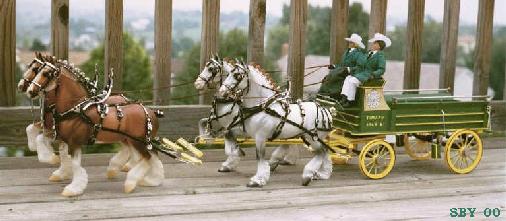 Two are part of an Eight-hitch: one is in Canada, and the other is my own, earlier one. The third case is very early, circa 1984, and resides in MD. Berg's is the only one specifically fitted to Stone Trotters, the only one to have stainless steel hardware, the only one with silver-color Rio Rondo hames, and---now---the only one with 3 brands of 2 sizes of harness brasses amoung four horses. Lesson learned: Plan Ahead for harness!!!
Two are part of an Eight-hitch: one is in Canada, and the other is my own, earlier one. The third case is very early, circa 1984, and resides in MD. Berg's is the only one specifically fitted to Stone Trotters, the only one to have stainless steel hardware, the only one with silver-color Rio Rondo hames, and---now---the only one with 3 brands of 2 sizes of harness brasses amoung four horses. Lesson learned: Plan Ahead for harness!!!
The Four-Hitch was shipped in October, 2000.
Close Ups

|
#92. This is a very old, stamped and painted parade set, dating back to 1984. Until last summer, I had no pictures of it, only written records. Thank you, Cheryl, for giving me the chance to freshen and conserve it! The saddle was originally sold to Marney Walerius.
|

|
Close up view of #54, created January 1985, using the old stamp and paint method. The drawback is that the paint greys... but the benefit is that this construction method is stable and lasts a very long time with minimal maintenance. Originally sold to G. Haskett, now owned by C. Monroe. Very minor preservation work was carried out, such as polishing the silver, freshening the paint and replacing steel rings with stainless steel ones.
|
 Updating, restoring, altering, customizing, rebuilding: no matter what you call it, it makes so much sense. It's cheaper and easier than buying new and it gives invaluable practice. Why make the job harder for yourself? Besides the fun of raising some piece of tack up to a higher level of detail, there is also knowledge to be gained about repair. Believe me, model tack needs repairing! just like its full size counterpart. The TSII has seen its full share of repair jobs --- it is always wonderful to spend time with old friends. This page tells the stories of several Parade sets and one Four-hitch of draft harness, all of them restored or rebuilt in some fashion.
Updating, restoring, altering, customizing, rebuilding: no matter what you call it, it makes so much sense. It's cheaper and easier than buying new and it gives invaluable practice. Why make the job harder for yourself? Besides the fun of raising some piece of tack up to a higher level of detail, there is also knowledge to be gained about repair. Believe me, model tack needs repairing! just like its full size counterpart. The TSII has seen its full share of repair jobs --- it is always wonderful to spend time with old friends. This page tells the stories of several Parade sets and one Four-hitch of draft harness, all of them restored or rebuilt in some fashion.
 Some of the tape had begun falling off. It is seen here restored, with missing places retaped and the whole set carefully conserved by lacing down with Mylar tinsel. Click on the close-up of his shoulder, and see if you can spot the slightly-brighter silver areas where the Mylar lacing holds down the silver tape. Some are at the top of the shoulder, others at the top of the tapadero, and at the chest edge of the rectangular plate next to the chest shield. To repair a set like this, some places need invasive surgery (the corners of the triangle-shaped plate) and some places hide the lace perfectly (the small squares). Each parade set has different needs.
Some of the tape had begun falling off. It is seen here restored, with missing places retaped and the whole set carefully conserved by lacing down with Mylar tinsel. Click on the close-up of his shoulder, and see if you can spot the slightly-brighter silver areas where the Mylar lacing holds down the silver tape. Some are at the top of the shoulder, others at the top of the tapadero, and at the chest edge of the rectangular plate next to the chest shield. To repair a set like this, some places need invasive surgery (the corners of the triangle-shaped plate) and some places hide the lace perfectly (the small squares). Each parade set has different needs.

 These two shots show the breastcollar of parade saddle TSII #306, BEFORE (feathers) and AFTER (still have to put the feathers back on). Note how the rays were falling off the near shoulder panel, and the triangles missing. I had to pierce the silver tape to hold down the triangles; note the dimples. For the squares and diamonds, the needle slit punch fit easily into the edge shadows.
These two shots show the breastcollar of parade saddle TSII #306, BEFORE (feathers) and AFTER (still have to put the feathers back on). Note how the rays were falling off the near shoulder panel, and the triangles missing. I had to pierce the silver tape to hold down the triangles; note the dimples. For the squares and diamonds, the needle slit punch fit easily into the edge shadows.  My usual method of lacing is not with a needle, but by cutting a point to the end of the Mylar tinsel, and using a sharp thin awl to open up the holes. Delicacy is called for so as not to tear the silver tape.
My usual method of lacing is not with a needle, but by cutting a point to the end of the Mylar tinsel, and using a sharp thin awl to open up the holes. Delicacy is called for so as not to tear the silver tape.
 If it is left uncovered, access is easy in case further repairs are needed... a caution that is only fair and reasonable. But on a black saddle, the glittery ends, tied anyhow, are a mighty distraction. On the three sets done so far, I've lined the concerned panels with thin black suede or other very thin leather. At the time, the way I lined was to bevel the edges of suede extremely thin and glue down the lot. (Later, possession of very thin black leather solved this problem.) The lining adds beautiful heft and a feeling of strength and security, as well as a wonderful black softness to the tack. It also completely removes any chance to further repair the silver tape or Mylar in the future. :( All I can say is experiments are continuing. Perhaps I can sew down linings in the future...
If it is left uncovered, access is easy in case further repairs are needed... a caution that is only fair and reasonable. But on a black saddle, the glittery ends, tied anyhow, are a mighty distraction. On the three sets done so far, I've lined the concerned panels with thin black suede or other very thin leather. At the time, the way I lined was to bevel the edges of suede extremely thin and glue down the lot. (Later, possession of very thin black leather solved this problem.) The lining adds beautiful heft and a feeling of strength and security, as well as a wonderful black softness to the tack. It also completely removes any chance to further repair the silver tape or Mylar in the future. :( All I can say is experiments are continuing. Perhaps I can sew down linings in the future...
 The set was made for Breyer's Belgian, and used exclusively Sojourner Studio harness brasses (made by Sue Rowe). Little did I know those brasses were to be involved in 20 months of gridlock.
The set was made for Breyer's Belgian, and used exclusively Sojourner Studio harness brasses (made by Sue Rowe). Little did I know those brasses were to be involved in 20 months of gridlock.
 Sue said she would send me the last ones left... and in one of those horrible postal flukes, they never arrived. :(
Sue said she would send me the last ones left... and in one of those horrible postal flukes, they never arrived. :(
 Two are part of an Eight-hitch: one is in Canada, and the other is my own, earlier one. The third case is very early, circa 1984, and resides in MD. Berg's is the only one specifically fitted to Stone Trotters, the only one to have stainless steel hardware, the only one with silver-color Rio Rondo hames, and---now---the only one with 3 brands of 2 sizes of harness brasses amoung four horses. Lesson learned: Plan Ahead for harness!!!
Two are part of an Eight-hitch: one is in Canada, and the other is my own, earlier one. The third case is very early, circa 1984, and resides in MD. Berg's is the only one specifically fitted to Stone Trotters, the only one to have stainless steel hardware, the only one with silver-color Rio Rondo hames, and---now---the only one with 3 brands of 2 sizes of harness brasses amoung four horses. Lesson learned: Plan Ahead for harness!!!

